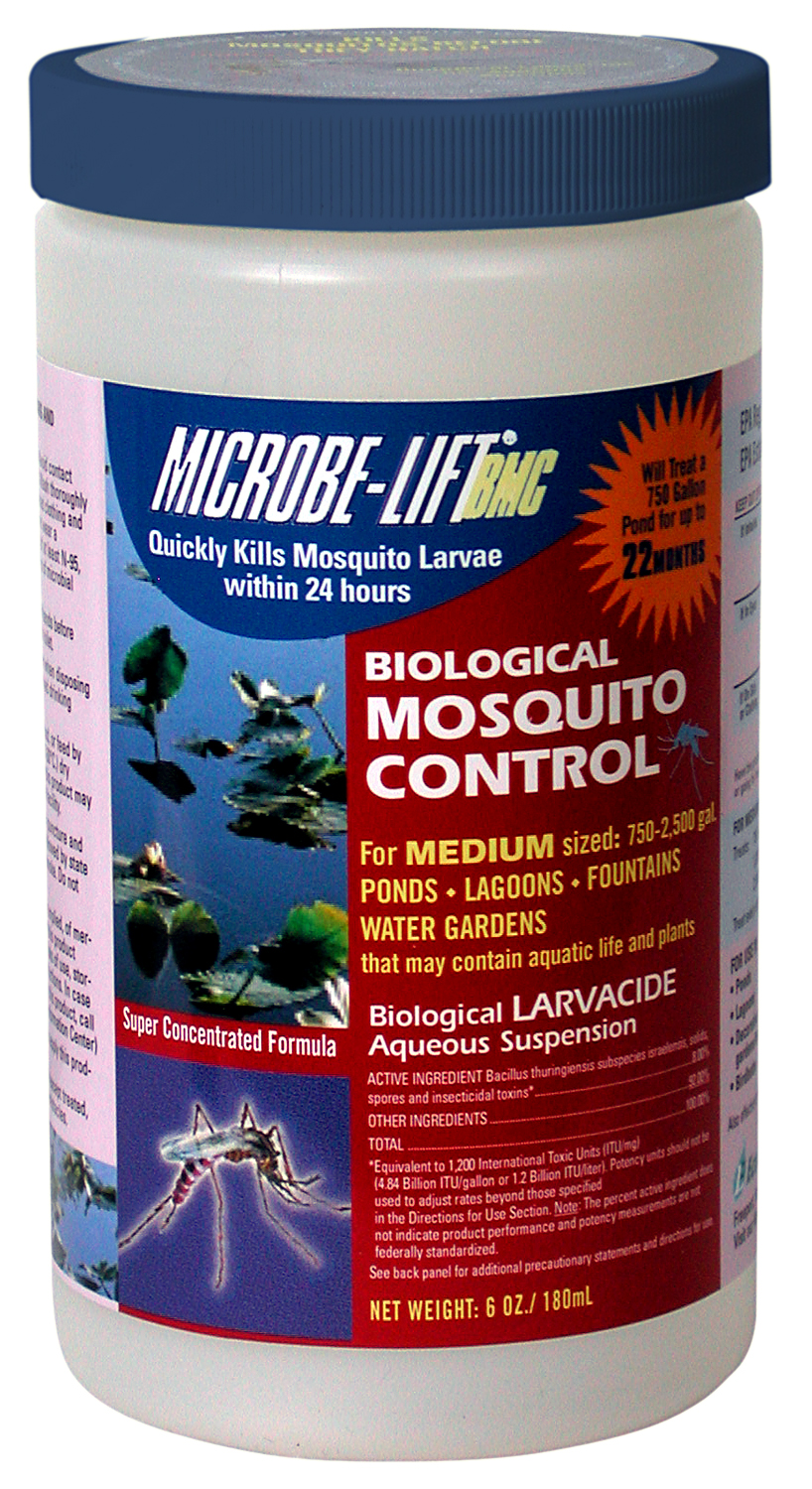
BMC is safer than the city’s overhead spray of insecticides that kill all insects, good or bad, and will leave the chemical in your pond and birdbaths or fountains. It is safe for water gardens that contain fish and plants. It works up to 14 days to eliminate the larvae in water. It can also be sprayed (1 pint will cover an acre!) because a mosquito only needs a thimble of water to lay eggs.
There is zero toxicity! None, nil, nothing that will affect the fish, invertebrates or your dogs and cats that drink from the water features in your yard. There is nothing to see or distract your view when enjoying your pond.
The Bti bacterial spores spread out across a pond and forms a layer about 2” from the surface, right where the tiny larvae wrigglers are feeding. And it isn’t going to attract more mosquitoes from neighboring areas… Just add a dose (6 drops per 100-gallons) every 2 weeks throughout the mosquito season.
What will you be protecting yourself and loved ones from? Viral diseases such as: malaria, dengue, Zika, Yellow fever, West Nile, Japanese encephalitis, and Chikungunya. And, I’m sure you know somebody who has contracted the bacterial disease of Lyme. Right now, we need to be aware of West Nile virus and Lyme Disease although animals are still dying of encephalitis.
When the temperatures heat up, mosquitoes are out on the prowl. Their bites are itchy and annoying, but these insects can also carry pathogens that may cause disease.
Learn more about how mosquitoes spread diseases and get the facts on some of the most common mosquito-borne illnesses.
How do mosquitoes spread disease?
It’s a popular misconception that all mosquitoes spread disease. There are more than 2,700 species of mosquitoes in the world, and only some can become infected with pathogens and may spread disease. Furthermore, not all mosquitoes feed on blood. Only female mosquitoes do, and they use the proteins contained in it to produce eggs.
Mosquitoes that can both become infected with and transmit a pathogen are referred to as vectors. In order for a mosquito to become a vector, the virus must survive the insect’s immune system and be present in its saliva. When a female mosquito bites a host, it releases saliva, which numbs the host and acts as an anticoagulant. If a virus is present, infection may occur.
Additional factors, such as environmental conditions and the amount of virus ingested by the mosquito, can affect the likelihood that it can spread disease.
Dengue fever
According to the Centers for Disease Control and Prevention, nearly 400 million people are infected with dengue fever each year. This mosquito-borne illness is spread by the Aedes aegypti mosquito. It emerged in the 1950s and is a leading cause of death in tropical and sub-tropical climates, including areas of Africa, the Americas, the eastern Mediterranean, southeast Asia and the western Pacific. Although it is relatively uncommon in the United States, small, isolated incidents have occurred in Florida and Hawaii. Most incidents of dengue fever in the U.S. are travel related.
Symptoms associated with dengue fever include a high fever coupled with severe headache, pain behind the eyes, joint pain, muscle and bone pain, rash and mild bleeding (gums or nose). In some cases, dengue fever may evolve into a more severe and potentially fatal condition called dengue hemorrhagic fever, or severe dengue. Severe dengue is characterized by vomiting, severe abdominal pain and difficulty breathing.
The Centers for Disease Control and Prevention recommends that people who believe they have dengue fever get rest and fluids, take pain relievers with acetaminophen (avoid aspirin) and consult their physician. Anyone experiencing symptoms of dengue hemorrhagic fever should seek emergency medical care.
Chikungunya
Like dengue fever, chikungunya is most commonly spread by the Aedes aegypti mosquito, but it can also be spread by the Aedes albopictus mosquito. First reported in Tanzania in 1952, the disease is most commonly found in Africa, Asia and India. The Centers for Disease Control and Prevention notes that the virus was first seen in the Americas during an incident in the Caribbean in 2013.
Symptoms of chikungunya are similar to dengue fever. It is most often characterized by fever and joint pain but may also include muscle pain, headache, nausea, fatigue and rash. According to the World Health Organization, most patients diagnosed with chikungunya recover fully.
There is no vaccine for chikungunya, but the CDC recommends rest, fluids and acetaminophen (not aspirin) to reduce fever.
Malaria
Perhaps the most well-known and deadly mosquito-borne illness, malaria is caused by a parasite. It is typically spread by the female Anopheles mosquito, but it may also be spread through blood transfusions, organ transplants or shared needles.
The disease is most prevalent in sub-Saharan Africa and south Asia. The Centers for Disease Control and Prevention reports that each year, there are roughly 1,700 cases in the United States, but these are primarily travelers returning from areas where the disease is easily transmitted.
Malaria symptoms usually include fever, chills and flu-like symptoms. Headaches, muscle aches, tiredness and vomiting may also occur. If malaria is left untreated, it can lead to kidney failure, confusion, coma and death.
The Centers for Disease Control and Prevention notes that malaria can be treated with prescription drugs, although the specific drug and course of treatment will depend on the strain of the disease.
West Nile
West Nile virus can be spread to humans through the bite of an infected Culex mosquito. The disease was first detected in humans in the West Nile region of Uganda in 1937, but it is now found throughout Africa, Europe, the Middle East, west Asia and Australia. It is also found throughout North America. According to the Centers for Disease Control and Prevention, West Nile cases have been reported in all of the continental United States.
There is no vaccine for West Nile virus, but the World Health Organization estimates that 80% of people infected with the disease show no symptoms at all. When symptoms are present, they include fever, headache, body aches, joint pains, vomiting and diarrhea. In very rare cases, patients can develop central nervous system conditions like encephalitis or meningitis.
The Centers for Disease Control and Prevention recommends over-the-counter medications to relieve symptoms and hospitalization for severe cases.
Zika
You may have heard about the Zika virus on the news in recent years. This disease is most commonly spread by the yellow fever and Asian tiger mosquitoes. It originated in Uganda but has now spread throughout Africa, the Americas, Asia and the Pacific. The Zika virus is present in the United States, and although it is not widespread in the country, it has been found in Illinois, Florida, Texas, New York, Utah and New Jersey.
Many people infected with Zika will not experience any symptoms. When symptoms are present, they are usually mild and include fever, skin rashes, muscle and joint pain, fatigue and headache. The virus can be passed from mother to fetus and lead to birth defects like microcephaly, or smaller-than-average head size.
There is no vaccine for Zika, but the Centers for Disease Control and Prevention recommends getting plenty of rest and fluids, as well as treating the symptoms with acetaminophen.
____________________________________________________________________________
Lyme
Lyme disease is commonly known to be transmitted from tick bites in North America, Europe, and Eurasia. However, research has shown that insects other than ticks can harbor the bacterium. Based on a study in Germany, it has been shown that Borrelia can survive in mosquitos from larval stages to adult stages without dying (1). Normally, Borrelia produces a protein that allows for its survival in a tick until the tick begins to feed and the bacteria can exit the tick into a new host. The bacteria are less likely to be able to survive in a mosquito’s gut due to chemical differences and gut composition. However, mosquitoes feed more often than ticks, therefore reducing the amount of time needed for the Borrelia to survive before transmission to a new host.
Additionally, Borrelia was isolated from mosquitoes and horse flies in a study conducted in 1988 by Magnarelli and Anderson from the Department of Entomology in New Haven, Connecticut. The sources of infection for these insects were not identified in the study. However, it was inferred that the prevalence of Borrelia in these two other winged groups may be due to high concentrations of cattle, horses, and deer that were exposed to Lyme disease through tick bites. The local cattle and large mammals tested had antibodies to Lyme disease, but no spirochetes were isolated.
Although the study did not find a reservoir of infection, it did provide interesting data that showed Borrelia could survive in organisms besides ticks. In addition to larger mammals, mice in the area where the study was conducted were known to be infected with Borrelia and lends evidence that the area the research group sampled from had Borrelia in its sylvatic cycle. Mosquitoes and horseflies that suck blood regularly may have a higher chance of picking up and transmitting Borrelia from one or more infected hosts (2). The paper also cites that although anecdotal, there have been records of deer fly bites and the subsequent development of the erythema migrans rash.
Although there has not been conclusive evidence that mosquitoes and flies can transmit Lyme disease to humans, there have been particular anecdotal cases of transmission in addition to the evidence that Borrelia can survive within these organisms. It may be worthwhile for research organizations to conduct further studies that investigate this non-tick vector mode of transmission because Lyme Disease could be far more prevalent than once thought. (2017 Hardy/Klavins)




